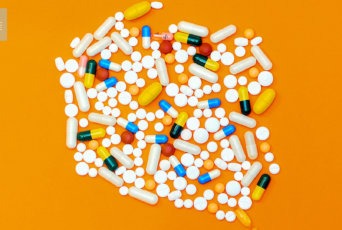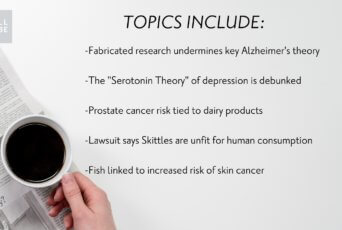Trying to stay on top of health- and wellness-related news and events can be overwhelming. It’s a lot to digest (pun intended). We saved you the trouble. Here’s what happened in June and July 2019, WellBe-style.
1. Processed Food Drives Weight Gain…And Americans Can’t Stop Eating It
What: In what’s being described as a “landmark” study, researchers definitively found that eating processed food drives weight gain. Meanwhile, another study shows that Americans are eating the same amount of processed meat that they did 18 years ago, despite increasing awareness around its health risks.
The Details: The weight gain study is the first randomized, controlled trial to find that eating ultra-processed foods causes people to overeat and gain weight, as compared with a diet made up of whole foods (with both groups eating equally nutritious meals). Researchers at the National Institute of Health selected 20 healthy, stable- weight adults to live in an NIH facility for two weeks, with half of them assigned a diet of whole or minimally processed foods, and half a diet of ultra-processed foods. They found that those assigned to the ultra-processed diet ate an average of 508 more calories per day and gained an average of two pounds; the other group, meanwhile, lost an average of two pounds during the two weeks.
It’s also notable that the weight gain occurred despite the fact that each meal offered on the two diets contained the same total amount of various nutrients: fat, sugar, salt, protein, carbohydrates, and fiber. Participants on the processed diet ended up eating way more at their meals, though they didn’t rate those meals as tastier. Previous studies have shown a link between processed food and weight gain, but those studies were all observational, and so researchers could only conclude that there was a correlation, not a causal relationship.
At the same time, a study published in the Journal of the Academy of Nutrition and Dietetics showed that Americans are eating less red meat than they did nearly two decades ago, but that processed meat consumption has remained the same. In the study, researchers out of Tufts University analyzed 18 years of data from 44,000 adults over the age of 20, and found that processed meat consumption has remained the same since 1999, with lunch meat, sausage, hot dogs, ham, and bacon as the top five sources.
Why Does This Matter for My Health? Over the past 70 years, ultra-processed foods have become an increasing part of the American diet, and there’s a scary lack of awareness around not only the risks of eating processed food, but also what counts as processed food. While U.S. dietary guidelines say that processed meat is part of a balanced diet, the World Health Organization classifies it as carcinogenic (i.e. causing cancer. Yup, seriously), and this new study on weight gain shows that processed non-meat items have their own negative health impact. What’s more, many of us assume that if we don’t eat things like chips, candy, or packaged cookies, we’re not consuming processed food; unfortunately, it’s not as straightforward as that. “Healthy” items like cereal, yogurt, chicken sausage, even whole wheat bread, are often still ultra-processed. Most food products with ingredient lists longer than five things you recognize are likely a processed food item.
The WellBe Takeaway: With these two new studies highlighting the health risks of processed food, we’re hopeful that the U.S. will take a cue from countries like Australia, Chile, Israel, and the U.K., which have all passed food label requirements warning consumers when a processed food item contains harmful ingredients or has a high content of sugar, sodium, or fat. But in the meantime, we’ll continue to check the ingredients on labels, and steer clear of any food item that has a list of ingredients more than ~5, and make sure we understand what those five things are! If you can’t pronounce it or have never heard of it, forget it. It’s likely processed and now we have proof it’s going to make you eat more of it and gain weight.
2. Low Childhood Nature Exposure Linked to Worse Adult Mental Health, and Scientists Determine How Much Nature Exposure Is Enough
What: A new study showed that kids who weren’t exposed to much nature during childhood were more likely to have worse mental health as adults. At the same time, scientists have pinpointed just how much nature exposure is sufficient to reap the health benefits.
The Details: For the first study, researchers in Europe collected questionnaire data from 3,585 participants, aged 18-75. The results showed that adults with low levels of childhood exposure to natural outdoor environments had significantly worse mental health and lower perceived energy, as compared to adults who had spent more time in nature as kids. This is the first study of its type, and more research is needed to confirm these findings and determine how, exactly, childhood nature exposure connects to adult mental health.
But what is considered “low” nature exposure? How much should kids — or adults — be getting? A new paper, published in Scientific Reports, may have the answer: 120 minutes a week. The researchers arrived at this number by looking at survey data from nearly 20,000 people in England, who were asked to record their activities within the past week. They found that spending two hours a week in the outdoors was associated with better health and a greater sense of well-being, as compared to those who spent little to no time in the outdoors. Spending significantly more time outdoors (five hours or more) offered no extra health benefits. These findings held true regardless of age, sex, ethnicity, class, or health issues.
Why Does This Matter for My Health? The health benefits of nature have long been known — doctors around the world have even begun prescribing time in nature as a way of improving patients’ health — but there isn’t a lot of information around how childhood exposure to nature impacts adult health, nor how much nature is enough. These two new studies point toward pretty definitive answers to both of those questions. While more research is still needed, these studies offer important pieces of knowledge to those of us raising kids, and anyone who doesn’t already make time for nature. The information about 120 minutes per week is particularly useful, since it helps those of us with packed schedules (um, hi!) ensure we’re making enough time for the great outdoors.
The WellBe Takeaway: Both of these studies underscore the importance of nature in our day-to-day lives (yes, every day), no matter what that looks like. It doesn’t need to be a hike through the mountains or a camping excursion — just taking a walk through a park or along a river is better than nothing. As the lead researcher from the time-in-nature study says, “nature is not like a pill you get prescribed by your doctor…what matters most is that you’re able to fit it into your lifestyle.” So even if it just means 20 minutes in a park on our lunch break, we’re going to make sure that city life doesn’t get in the way of finding time for nature.
3. Keurig Dr. Pepper Pulls Its Spring Water Brand for Arsenic Content
What: Keurig Dr. Pepper announced that it was withdrawing its Peñafiel brand mineral spring water products after reports that they contained high levels of arsenic. Wait seriously?!
The Details: The company made its announcement three days after the Center for Environmental Health notified them that tests of the water showed it exceeded the arsenic level required under California’s consumer protection law, and three days after Consumer Reports found it exceeded the level set by the federal government, which sets the standard at 10 parts per billion. The company’s withdrawal of the water is voluntary, as this is considered a “minor” violation that wouldn’t be subject to FDA legal action (arsenic in water is “minor”? Um…okay.). A spokesperson for Keurig Dr. Pepper said that after the product withdrawal, enhanced filtration systems were installed.
Consumer Reports and the Center for Environmental Health said that a Whole Foods-owned brand, Starkey Water, also exceeded arsenic levels they deemed safe, while still meeting federal standards (um, again…okay?).
Why Does This Matter for My Health? Arsenic is no joke. Chronic low-dose exposure has been linked to respiratory problems, cardiovascular disease, diabetes, and various types of cancer; it can also be harmful to developing fetuses and children, and have a negative impact on cognitive development, intelligence, and memory, according to the WHO. This is all scary stuff. Which is why it’s even more concerning that the FDA arsenic limit for bottled water is 10 parts per billion, which is the same limit set for public water systems. According to Consumer Reports, this is way too high — they suggest lowering the limit to three parts per billion, since people pay a premium for bottled water, often because they assume it’s safer.
The WellBe Takeaway: This most recent product withdrawal is a scary reminder that water is not just water, and that when it comes to drinking clean water, we need to take matters into our own hands. This means buying a reusable water bottle and filling it with filtered water, and making sure to do our research into the healthiest brands if we find ourselves in a pinch and need to purchase bottled water.
4. Baby Health Roundup: Breast Milk Colonizes Baby’s Microbiome, and Baby Acid Reflux Meds Lead to Later Bone Fractures
What: An increasing amount of research shows that an outsize proportion of the good bacteria in a baby’s gut microbiome actually comes from unpumped breast milk, while a new study links use of infant acid reflux drugs to bone fractures later in childhood.
The Details: It’s been known for a while that much of a baby’s microbiome comes from his or her mom — from the birth canal, from her skin and mouth, from her feces (in the case of a vaginal birth). New research shows that another major contributor is unpumped breast milk, which is teeming with good bacteria that colonizes infants’ guts and plays a big role in shaping their immune system and metabolism. The actual amount of bacteria in breast milk is significantly lower than that in stool (or poop), but advances in technology have shown that breast milk bacteria has a disproportionately large impact, populating the baby’s gut with good bacteria. Interestingly, the research also shows that babies only get this beneficial bacteria when the milk comes directly from the breast — ie, pumped breast milk that’s later delivered through a bottle doesn’t have the same impact.
Speaking of things we do to babies in their early days that affect them later on, a new study shows that infants who were given acid suppression medicines in their first year of life were at a significantly greater risk for bone fractures later in childhood. Researchers looked at records of more than 850,000 children, of whom 97,000 had received acid reflux medicines in infancy (8,000 were given proton pump inhibitors (PPI’s) like Nexium, 71,000 took histamine-2 receptor antagonists like Pepcid, and 18,000 got both). After controlling for factors like sex, preterm birth, and obesity, they found that those who were given PPI’s before age one had a 23% increased risk of fracture, while those given H2 antagonists at the same time were at a 31% increased risk for bone fracture.
Why Does This Matter for My Health? In terms of babies’ future health, this colonization by breast milk bacteria matters a lot. Poor gut health in early infancy is linked to obesity later in life, as well as type 1 diabetes, asthma, and other autoimmune diseases. Given that babies are, well, the future of the human population, this should matter to everyone, whether or not you have kids. And until now we really didn’t understand any health differences between breast milk and pumped-breast milk. This news could really affect the future of mothers and work.
The acid reflux research is similarly striking, since these drugs are given out fairly freely during infancy, and overwhelmed new parents are often eager to accept anything that will make their newborn happy. This new study should drive home the potential dangers of this kind of drug specifically, while raising the question of what health risks you’re posing to your baby when you accept any drug for them. And the truth is, babies spit up a lot (just ask WellBe team member Kate, who had a baby in April and doesn’t currently have any clothing not covered in the stuff) — and it’s perfectly normal. There’s no need to rush to medication, unless there’s a legit GERD diagnosis, and even then, there’s probably an alternate route besides medicine.
The WellBe Takeaway: We’re always wary about taking meds unless it’s absolutely necessary, and it seems like this should be exponentially true for fragile newborns. That’s why we’d skip any acid reflux meds offered, especially in the first year of life. In terms of breast milk, we’re definitely pro breastfeeding, and encourage all our readers with babies to breastfeed if they can. If breastfeeding directly is painful, this new research might make you consider getting to the root cause of why, rather than just assuming there is nothing you can do about it and exclusively pumping. At the same time, it’s a fraught issue for a lot of women, and there’s a lot of societal pressure floating around. So you do you, mama — but just take this information about the gut microbiome into consideration when you’re deciding how you want to proceed.
5. Commonly Prescribed Drug Class Linked to Increased Dementia Risk
What: A new study shows a very strong connection between the use of certain types of medications — called anticholinergic drugs — and dementia.
The Details: The study, out of the University of Nottingham in the U.K., observed that prolonged use of these particular drugs resulted in nearly 50% increased odds of dementia. Fifty. Percent. Mic drop. The drugs in question encompass a variety of different categories, including antidepressants, overactive bladder meds, antipsychotics, and antiepileptic drugs (some brand names you might have heard of are Bentyl, Artane, Oxytrol, and Symax.). Note that the risk was only associated with prolonged use: 1,095 doses within a 10-year period, which works out to taking a daily anticholinergic med for at least three years.
Why Does This Matter for My Health? Though you might never have heard of anticholinergic drugs, the reality is that doctors prescribe them for all sorts of conditions, everything from chronic obstructive pulmonary disease (COPD) to Parkinson’s to super common things, like allergies or gastrointestinal (GI) issues. This study is also important because the associated risk they found is so strong — seriously, 50%?! Given that 50 million people have dementia worldwide, there are nearly 10 million new cases every year, and that 5.7 million people in the U.S. have Alzheimer’s, this is a research we should all pay attention to.
The WellBe Takeaway: While it’s important to note that this study was observational, so no firm conclusions can be drawn, we’re certainly going to be wary of this class of drugs, and push back if a doctor wants to write us a prescription for one. We also hope that doctors will use this information to inform their prescription-writing decisions, and that they’ll weigh these potential risks against any benefits.
6. Judge Denies Trump Effort to Require Prices on Drug Commercials
What: A federal judge shot down the Trump administration’s regulation requiring drug companies to include prices in TV commercials. That pharma industry, pretty powerful right?
The Details: The regulation, which was announced in May, would have mandated that TV drug commercials disclose the price for any medication that costs more than $35 for a month’s supply or the usual course of treatment (this number was chosen because it’s roughly the average co-pay for most brand-name drugs). In June, Merck, Eli Lilly, Amgen, and the National Association of Advertisers filed a lawsuit against the administration, arguing that the regulation would mislead consumers about how much they needed to pay, since most of the cost would theoretically be shouldered by insurance companies.
Ultimately, the pharma companies and advertisers won the lawsuit, with a U.S. District Judge nixing the regulation on the grounds that the Department of Health and Human Services had overstepped its authority in creating this rule. In the words of the judge: “no matter how vexing the problem of spiraling drug costs may be, HHS cannot do more than what Congress has authorized. The responsibility rests with Congress to act in the first instance.”
Why Does This Matter for My Health? The healthcare industry is a mess (hello! — that’s kinda why we exist!), and part of that messiness comes from the INSANE prices of prescription drugs, as well as the byzantine ways in which insurance companies decide whether or not (and how much) to cover them. This regulation, as well as the court ruling, highlights how crazy the whole system is, and should get all of us fired up to push Congress to make a change. Sadly, given that the pharmaceutical industry is by far the highest spending industry on lobbying congress, we’re going to have to do a lot of pushing to make that happen.
The WellBe Takeaway: We think it’s crazy enough that the U.S. is one of just two countries in the world that allows direct to consumer advertising of drugs, so we were proponents of transparency around drug pricing to consumers. After all, we are paying for these drugs somehow, even if it’s through our insurance premiums or taxpayers). While some experts say that putting prices on commercials wouldn’t address the issue because the stated prices don’t reflect what most people with insurance would pay, it still would have been a step toward transparency in a largely opaque and impenetrable system. We’re counting this one as a loss.
7. Sugary Drinks Are Linked to Cancer — But We Can Do Something About It
What: A new study suggests a connection between drinking sugary drinks like soda and juice and the onset of cancer — but don’t lose hope: another study showed that Philadelphia has seen a significant drop in sugary drink sales since implementing a tax.
The Details: In the first study, published in BMJ, researchers looked at 24-hour food intake questionnaires (which included 97 sugary drinks) from 101,257 people, with an average age of 42. Over nine years, they observed 2,193 cases of cancer, and linked these cases back to participants’ consumption of sugary beverages. What they found was that, compared with the lowest 25% for sugary drink consumption, those in the highest 25% had a 30% higher risk for any cancer, and a 37% increased risk for breast cancer. While researchers aren’t sure what the link is, they think that sugary drinks might promote visceral (aka, stomach-area) fat deposits, and that since these deposits are around internal organs, they could promote tumor formation.
This is pretty sad news, especially considering how much soda Americans drink. But there’s news out of Philadelphia that gives us reason to be hopeful: two years after the city imposed a tax on soda and sweet beverages, a study shows that sales of sugary drinks in the area dropped by 38%! The tax —priced at 1.5 cents per ounce — is the second of its kind in the country, after Berkeley, CA implemented a similar sugary drink tax in 2016. The tax only applied to Philadelphia city proper, and so it’s not super surprising that there was an increase in sales just outside the city. But this increase, when averaged with the 51% drop within city limits, still came out to a net decrease in soda sales of 38% for the area.
Why Does This Matter for My Health? Though the cancer study is observational and doesn’t by any means say that sugar alone causes cancer, there’s no doubt that high sugar consumption poses all sorts of health risks, so we can just add one to the list. Americans consume a huge amount of sugar, and the result is an obesity epidemic, as well as epidemics of many sugar-related chronic diseases, including diabetes. This is a big deal, and should matter to every taxpayer, and frankly every American. Unfortunately, fighting these trends will take more than just educating the public about sugar risks. What we need are massive, high-level interventions that make sugar less accessible. The tax in Philadelphia is a hopeful sign that this can work on a large scale.
The WellBe Takeaway: We already skip sugary drinks over here — just a splash of 100% fruit juice in some sparkling water now and then — and this research reinforces our commitment to doing so. The findings out of Philadelphia also give us renewed energy to keep fighting the good fight and pushing for healthier policies. It does make a difference! After all, if cigarettes can be taxed because they contribute to disease, why not sugar?
8. Factory Farm Chicken Has the Same Cholesterol Levels As Beef
What: The first analysis to comprehensively compare the impact of red meat vs. white meat on cholesterol found that factory-farmed chicken and beef were equivalent in terms of their effect on cholesterol.
The Details: Researchers from the Children’s Hospital Oakland Research Institute looked at how blood cholesterol levels were affected by red meat and white meat, and were surprised to find that the respective effects of chicken and beef were identical. They tracked how red meat, white meat, and plant protein all impacted cholesterol levels, and determined that both types of meat led to higher blood cholesterol levels than diets that contained significant plant protein. This result was true even after accounting for a high intake of saturated fats.
Why Does This Matter for My Health? These findings throw into question government nutrition guidelines, which encourage consumers to eat poultry as a healthier alternative to beef, as well as a general agreement among most of us that chicken is “good” or at least “better” for you. High (bad) cholesterol can lead to serious heart issues down the line, so this research should be an impetus for all of us to seek out plant protein as a substitute for red and white meat as much as possible.
The WellBe Takeaway: We’re taking this study as further reason to try to eat primarily plant-based, but also noticed that neither fish nor grass-fed beef and chicken were included. We’d be interested in seeing a study that compares these types of animal protein and their impact on cholesterol!
Other news worth noting:
-
Can Gene-Edited Mice in Nantucket Cure Lyme Disease? (Elemental)
-
Insomnia Can Kill You (New York Times)
-
Leaked FDA Study Shows Toxic “Forever” Chemicals Contaminate Many Foods (CNN)









COMMENTS